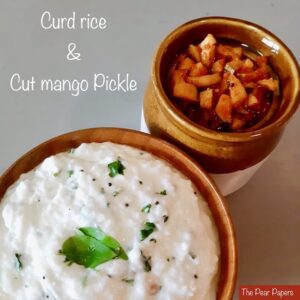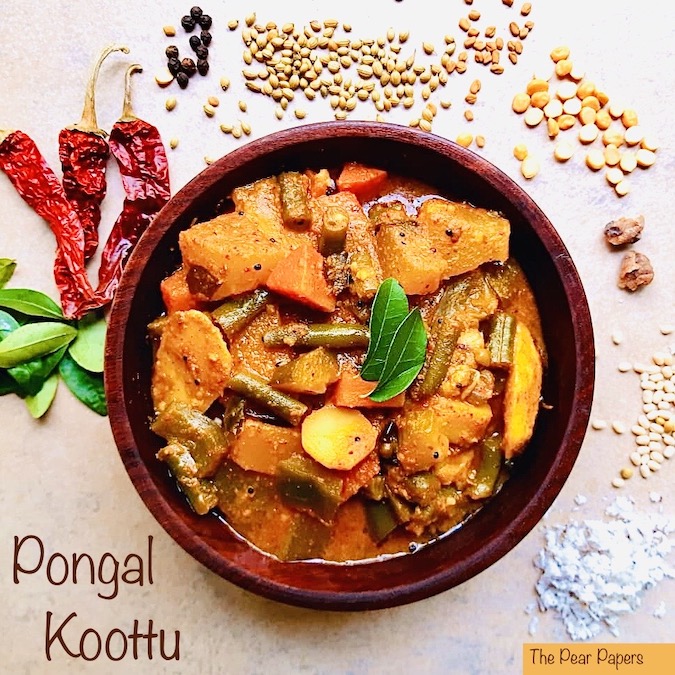
Pongal Koottu
Pongal Koottu prepared during the South Indian festival ‘Pongal’ is a semi gravy dish, made with a combination of vegetables, legumes, coconut and spices. Any day I prefer koottu as a main dish in my plate because it’s so nutritious, easy to make and very light on the stomach. I can reduce the carbs I consume if I have koottu in any meal. This Pongal Koottu is made with lots of various colourful vegetables (both root vegetables and green vegetables). It has two sources of protein (black eyed beans/chick peas/peanuts/dried green peas along with toor dhal). And, it is salty, sour, spicy and sweet – all packed in one dish.
During harvest season (mainly during January), there will be an abundance of so many vegetables and it is a traditional practice to make this Pongal Koottu with these freshly harvested seasonal vegetables. Originally this dish was made with a mix of locally grown vegetables like ash gourd, yellow pumpkin, brinjal, broad beans, cluster beans, snake gourd, long beans, raw banana, yam, colacasia and sweet potato. Nowadays, with the availability of so many vegetables throughout the year, around the globe, we tend to add many more vegetables like fresh beans, carrot, potato, chayote, fresh peas, cucumber etc. The more variety you add, more nutritious and tasty it is. Feel free to increase the number of vegetables according to your choice and availability.
Pongal Koottu tastes great with VeN Pongal, plain rice, as a side dish for any rasam rice, coconut rice, thiruvadhirai kali and curd rice. You can also just have a large bowl of this koottu with some plain yoghurt for a wholesome nutritious low fat meal!
Ingredients
Mixed vegetables (cubed) – 6 to 7 cups
Thick tamarind extract/paste – 2 tbsp
Black eyed beans – 1/2 cup
Toor dhal – 1 cup
Cooking sesame oil – 2 1/2 tbsp
Turmeric powder – 1 tsp
Mustard seeds – 1 tsp
Urad dhal – 1 1/2 tbsp
Curry leaves – few leaves
Chana dhal – 1 tbsp
Coriander seeds – 2 tbsp
Dry red chilly – 5 (or to taste)
Whole black pepper – 1 tsp
Fenugreek seeds – 1/2 tsp
Asafoetida – 1 tsp
Fresh grated coconut – 4 tbsp
Salt – 1 1/4 tsp (or to taste)
Jaggery – 1 tbsp
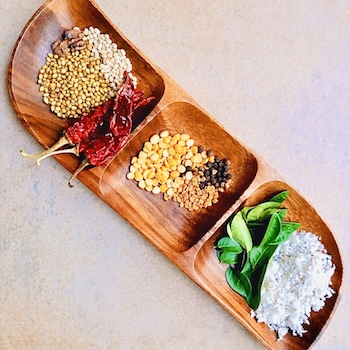
Yield
Serves 5
Prep time
20 minutes on the day
Overnight soaking for black eyed beans
Cook time
~40 minutes
Method
1) Soak black eyed beans overnight. The next day, boil these soaked beans and toor dhal together along with 1/2 tbsp cooking sesame oil and 1/2 tsp turmeric powder until soft. Set aside.
2) Keep 2 tbsp fresh grated coconut in a plate. Heat a pan and add 1 tbsp sesame oil. Add 1/2 tbsp urad dhal, chana dhal, coriander seeds, dry red chilly, black pepper and fenugreek seeds. Fry these in minimum heat until dhal becomes golden. Now add asafoetida and mix well. Transfer this mixture on top of the coconut (that we have kept on a plate) and mix. When this mixture cools down a bit, grind with minimum water to a nearly smooth paste. Set aside.
3) In the same pan heat the remaining 1 tbsp sesame oil. When slightly heated up, add mustard seeds and wait for it to splutter. Then add 1 tbsp urad dhal and fry until golden. Now add the curry leaves and the remaining 2 tbsp grated coconut. Fry until the coconut turns golden. Set this tempering aside.
4) In a wide pan/kadai take the cubed vegetables. Add salt, 1/2 tsp turmeric powder and some water. Cover the pan and let the vegetables cook until half done. When the vegetables are half cooked, add the tamarind extract and mix well. Again cover the pan and continue to cook until the root vegetables are cooked fully.
5) When the vegetables are cooked, add the cooked dhal and black eyed beans. Mix well and allow it to boil for 2 mins. Add jaggery and the ground mixture and mix thoroughly. Simmer the heat and let the Pongal Koottu boil for 2 mins.
6) Finally, add the tempering to the koottu and give it a quick stir. Tasty and healthy Pongal Koottu is ready to be served!
Notes
- I generally prefer to soak my black eyed beans (or any other legume) overnight. When lentils/ legumes are soaked for at least a few hours before cooking, they cook faster and it also helps in better absorption of the nutrients in them. Soak and discard the soaked water before cooking and add fresh water when you cook them (there are several benefits to this such as reducing gassiness, removing unwanted components like tannins, etc).
- Check out my sundal recipe for another super healthy way to use black eyed beans!
- Use fresh grated coconut or coconut milk for this koottu. Dry coconut kernel (called ‘kopparai thengaai’ in Tamil), can also be grated and used. Dessicated coconut will not taste good for this recipe.
- Grind the masala paste with minimum water. After adding the masala paste, adjust the consistency of the koottu with some water to bring it to a gravy consistency.
Beginner’s tips
- Fry all ingredients for the masala paste in minimum heat. Take time to roast slowly, so that the ingredients fry completely without getting charred. Moreover, slow roasting helps in releasing the natural aroma of each ingredient and enhance the overall taste of the dish.
- Cook your veggies until just crunchy (al dente) to retain their natural colour and texture. In general, vegetables are healthier the lesser you cook them!


You May Also Like
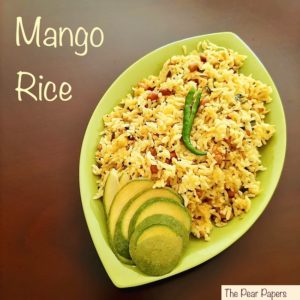
Mango Rice
September 29, 2021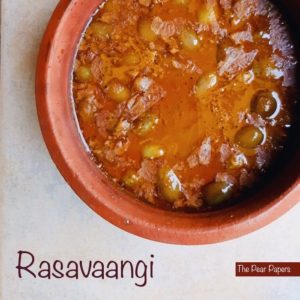
Rasavaangi
February 27, 2022